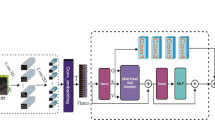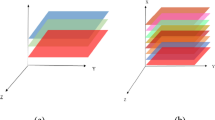Abstract
In recent years, collaborative representation (CR)-based models have been widely used in hyperspectral image (HSI) classification. And many CR models utilize Tikhonov regularization term to improve the classification performance. However, this regularization term greatly increases the running time of CR models due to calculating the Euclidean distance between the test sample and all the training samples. Moreover, most of CR models utilize the training samples of all classes to represent the test sample, which may make the classes irrelevant to the test sample produce an impact on the classification performance of CR. To solve the above problems and further improve the classification performance of the CR model, a novel Euclidean distance-based adaptive (EDA) dictionary learning method is proposed in this paper, which aims to construct a subdictionary by selecting the k-nearest neighbor classes relevant to the test sample using Euclidean distance. And the EDA method is integrated into the original collaborative representation classifier (CRC) and the CRC with Tikhonov regularization (CRT) methods for HSI classification, which is denoted as EDACRC and EDACRT, respectively. The proposed methods are evaluated on the Botswana, KSC, and Salinas-A datasets, in which the classification performances and running times of these methods are analyzed and compared. The experimental results demonstrate that the proposed EDA method can not only effectively reduce the running time of the CR model with Tikhonov regularization, but also effectively eliminate some classes irrelevant to the test sample, thus improving the classification performance of the CR model.



Similar content being viewed by others
References
Akbari D, Homayouni S, Safari A, Mehrshad N (2016) Mapping urban land cover based on spatial-spectral classification of hyperspectral remote-sensing data. Int J Remote Sens 37:440–454
Chen H, Ye MC, Lei L, Lu HJ, Qian YT (2020) Semisupervised dual-dictionary learning for heterogeneous transfer learning on cross-scene hyperspectral images. IEEE J. Sel. Top. Appl. Earth Observ Remote Sens 13:3164–3178
Chen X, Li SY, Peng JT (2017) Hyperspectral imagery classification with multiple regularized collaborative representations. IEEE Geosci Remote Sens Lett 14:1121–1125
Chen Y, Nasrabadi NM, Tran TD (2011) Hyperspectral image classification using dictionary-based sparse representation. IEEE Trans Geosci Remote Sens 49:3973–3985
Clark ML, Buck-Diaz J, Evens J (2018) Mapping of forest alliances with simulated multi-seasonal hyperspectral satellite imagery. Remote Sens Environ 210:490–507
Du PJ, Gan L, Xia JS, Wang DM (2018) Multikernel adaptive collaborative representation for hyperspectral image classification. IEEE Trans Geosci Remote Sens 56:4664–4677
Gao QS, Lim S, Jia XP (2018) Improved joint sparse models for hyperspectral image classification based on a novel neighbour selection strategy. Remote Sens 10:905
Kayabol K, Kutluk S (2016) Bayesian classification of hyperspectral images using spatially-varying Gaussian mixture model. Digit Signal Prog 59:106–114
Li W, Tramel EW, Prasad S, Fowler JE (2014) Nearest regularized subspace for hyperspectral classification. IEEE Trans Geosci Remote Sens 52:477–489
Li W, Chen C, Su HJ, Du Q (2015) Local binary patterns and extreme learning machine for hyperspectral imagery classification. IEEE Trans Geosci Remote Sens 53:3681–3693
Li W, Du Q, Zhang F, Hu W (2015) Collaborative-representation-based nearest neighbor classifier for hyperspectral imagery. IEEE Geosci Remote Sens Lett 12:389–393
Li W, Du Q, Xiong MM (2015) Kernel collaborative representation with Tikhonov regularization for hyperspectral image classification. IEEE Geosci Remote Sens Lett 12:48–52
Li W, Du Q, Zhang F, Hu W (2016) Hyperspectral image classification by fusing collaborative and sparse representations. IEEE J. Sel. Top. Appl. Earth Observ Remote Sens 9:4178–4187
Liu H, Li W, Xia XG, Zhang MM, Gao CZ, Tao R (2021) Spectral shift mitigation for cross-scene hyperspectral imagery classification. IEEE J. Sel. Top. Appl. Earth Observ. Remote Sens 14:6624–6638
Liu JJ, Wu ZB, Li J, Plaza A, Yuan YH (2016) Probabilistic-kernel collaborative representation for spatial-spectral hyperspectral image classification. IEEE Trans Geosci Remote Sens 54:2371–2384
Liu Z, Tang B, He XF, Qiu QC, Liu F (2017) Class-specific random forest with cross-correlation constraints for spectral-spatial hyperspectral image classification. IEEE Geosci Remote Sens Lett 14:257–261
Lu T, Li ST, Fang LY, Jia XP, Benediktsson JA (2017) From subpixel to superpixel: a novel fusion framework for hyperspectral image classification. IEEE Trans Geosci Remote Sens 55:4398–4411
Ma Y, Li C, Li H, Mei XG, Ma JY (2018) Hyperspectral image classification with discriminative kernel collaborative representation and Tikhonov regularization. IEEE Geosci Remote Sens Lett 15:587–591
Su HJ, Zhao B, Du Q, Du PJ (2019) Kernel collaborative representation with local correlation features for hyperspectral image classification. IEEE Trans Geosci Remote Sens 57:1230–1241
Sun WW, Liu C, Xu Y, Tian L, Li WY (2017) A band-weighted support vector machine method for hyperspectral imagery classification. IEEE Geosci Remote Sens Lett 14:1710–1714
Tu B, Zhou CL, Liao XL, Zhang GY, Peng YS (2021) Spectral-spatial hyperspectral classification via structural-kernel collaborative representation. IEEE Geosci Remote Sens Lett 18:861–865
Wang B, Li WF, Poh N, Liao QM (2013) Kernel collaborative representation-based classifier for face recognition. Int Conf Acoust Spee:2877–2881
Wright J, Yang AY, Ganesh A, Sastry SS, Ma Y (2009) Robust face recognition via sparse representation. IEEE Trans Pattern Anal Mach Intell 31:210–227
Wu Q, Wang C, Fang JJ, Ji JW (2016) Field monitoring of wheat seedling stage with hyperspectral imaging. Int J Agric Biol Eng 9:143–148
Yang JH, Qian JX (2020) Joint collaborative representation with shape adaptive region and locally adaptive dictionary for hyperspectral image classification. IEEE Geosci Remote Sens Lett 17:671–675
Ye MC, Qian YT, Zhou J, Tang YY (2017) Dictionary learning-based feature-level domain adaptation for cross-scene hyperspectral image classification. IEEE Trans Geosci Remote Sens 55:1544–1562
Zhang EL, Zhang XR, Liu HY, Jiao LC (2015) Fast multifeature joint sparse representation for hyperspectral image classification. IEEE Geosci Remote Sens Lett 12:1397–1401
Zhang L, Yang M, Feng XC (2011) In Sparse representation or collaborative representation: which helps face recognition?, IEEE International Conference on Computer Vision, Barcelona, Spain, 2011; Barcelona, Spain. pp 471–478
Zhang YX, Li W, Tao R, Peng JT, Du Q, Cai ZQ (2021) Cross-scene hyperspectral image classification with discriminative cooperative alignment. IEEE Trans Geosci Remote Sens 59:9646–9660
Zheng CY, Wang NN (2019) Collaborative representation with k-nearest classes for classification. Pattern Recogn Lett 117:30–36
Acknowledgements
This work was supported by the National Natural Science Foundation of China (No. 32071680), the Beijing municipal construction project special fund, and the Project funded by ChinaPostdoctoral Science Foundation (No. 2022M713415).
Author information
Authors and Affiliations
Corresponding author
Ethics declarations
Conflict of interest
The author declares that there is no conflict of interest.
Additional information
Publisher’s note
Springer Nature remains neutral with regard to jurisdictional claims in published maps and institutional affiliations.
Rights and permissions
Springer Nature or its licensor holds exclusive rights to this article under a publishing agreement with the author(s) or other rightsholder(s); author self-archiving of the accepted manuscript version of this article is solely governed by the terms of such publishing agreement and applicable law.
About this article
Cite this article
Yang, R., Kan, J. Euclidean distance-based adaptive collaborative representation with Tikhonov regularization for hyperspectral image classification. Multimed Tools Appl 82, 5823–5838 (2023). https://doi.org/10.1007/s11042-022-13597-2
Received:
Revised:
Accepted:
Published:
Issue Date:
DOI: https://doi.org/10.1007/s11042-022-13597-2




